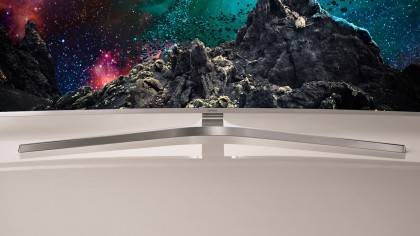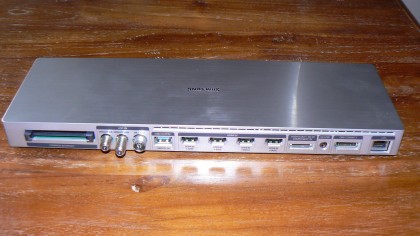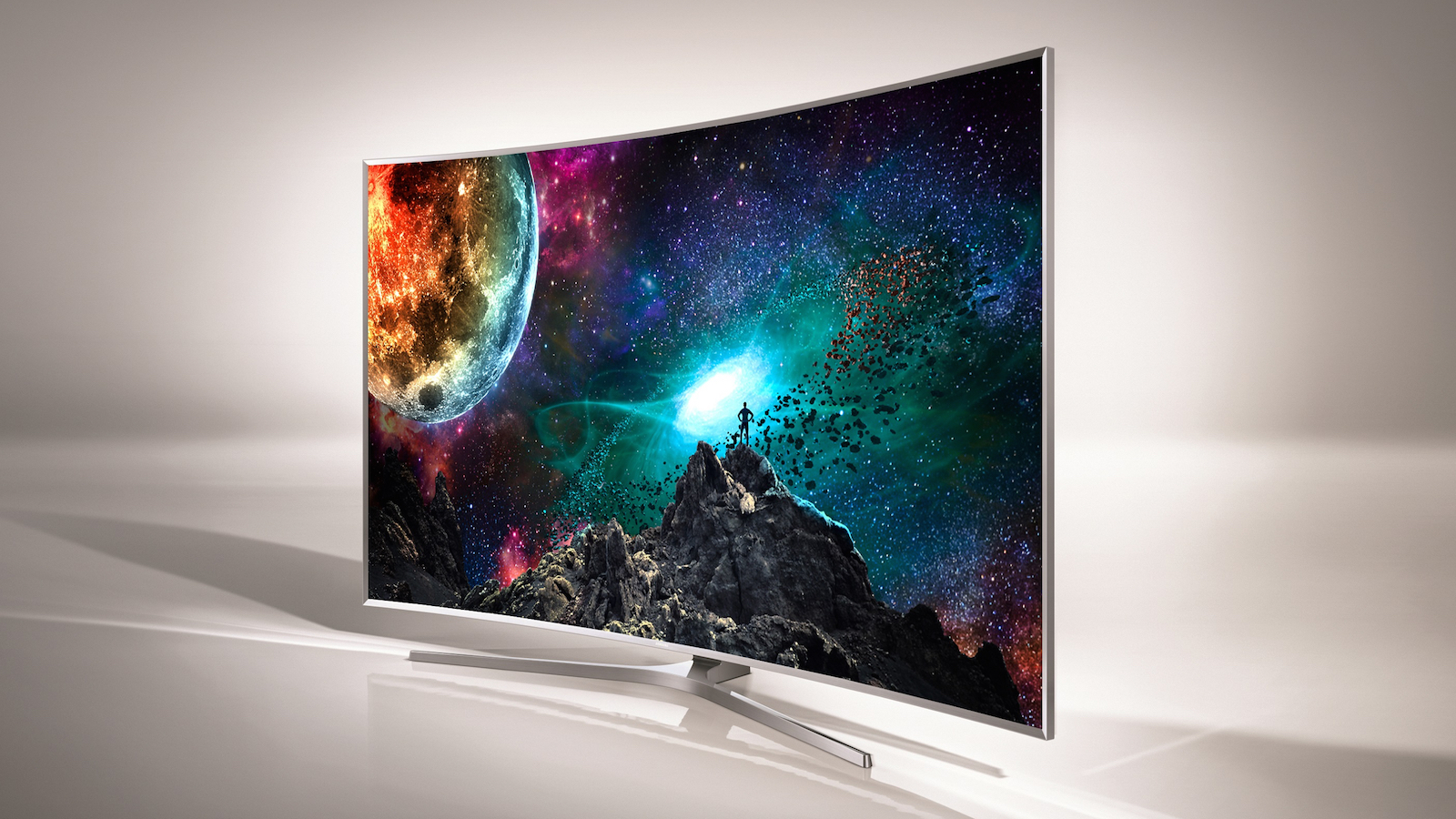TechRadar Verdict
With its high dynamic range (HDR) compatibility and native 4K resolution the UE65JS9500 is almost too futuristic for its own good given the current shortage of native HDR and 4K content. But it's also so damn brilliant that we'd recommend you save up to get one anyway and wait for the rest of the world to catch up.
Pros
- +
Ground breaking picture quality
- +
Tizen interface is effective
- +
Feature-rich smart TV platform
- +
Upgradable connectivity
Cons
- -
It's very expensive
- -
No native HDR content
- -
Limited native 4K content
- -
Curved screen is divisive
Why you can trust TechRadar
We only just started to vaguely get our heads round the idea of TV sets with 4K UHD native resolutions but now the ever-restless TV manufacturers have another brain bending thunderbolt to drop on us: high dynamic range - or HDR to its friends.
Having emerged from pretty much nowhere at this year's CES, you might think that HDR (the practice of filming, mastering and then playing back video with a far wider luminance range than you get with normal video) is still just a highfalutin concept, only likely to start finding its way onto working TV sets in three or four years time.
But no: the very first TV of the new 2015 range season, Samsung's 65-inch UE65JS9500 boasts both a native 4K UHD resolution and HDR playback. And at £5999.99 these features don't come cheap.
I'll have a more in-depth look at what this HDR compatibility actually means shortly. First, though, let's get some of the more straightforward stuff out of the way first. Starting with the UE65JS9500's design, which is striking to say the least.
Curvacious design
For starters its screen is very obviously curved. And before you ask, no, there isn't a flat version of the set. If you want the highest level of picture performance from Samsung's TV range this year, the only place you'll find it is in the curved screens of the JS9500 TVs.
Wrapped around the curved screen is one of the most striking bezel designs Samsung has delivered for years. It's finished in a posh looking chamfered metal, and the bezel's outer edges stand some distance proud of the screen, requiring the frame to angle back steeply as it gets closer to the screen.
Add to this a glowing Samsung logo (the glow can be turned off if you don't like it) and a seemingly 'impossible' stand design that somehow supports the whole huge expanse of screen on a single gently forward curving bar and you've got a TV that definitely demands your attention. Some may prefer a more subtle look, perhaps, but you certainly can't accuse Samsung's 2015 flag waver of being unattractive.
Sign up for breaking news, reviews, opinion, top tech deals, and more.

If you were feeling unkind, though, you could accuse it of being a bit portly. Its rear end sticks out much further than those of most modern TVs, exaggerating the sense of extra depth you already get with a curved screen.
The chunkiness is not really an issue if you're using the TV on its stand, as you don't feel aware of the rear heft from the front. But if you're thinking of hanging it up you will need to be prepared for it protruding quite some distance from your wall.
Connectivity
As with all of Samsung's flagship TVs over the past few years, the 65JS9500 puts the vast majority of its connections and processing inside an external 'One Connect' box. This has two advantages. First it means you only need a single cable, from the One Connect, going into the TV rather than the usual cable spaghetti.
Second and much more importantly, you could replace the current One Connect with a future upgraded version that could contain both Samsung's next generation of processing and smart TV features, and any new connection types that might appear.

This sort of future proofing is extremely comforting given current uncertainties over the latest HDMI 2.0 connector's potential for handling future (imminent) upcoming picture quality standards.
Let's get back now to the UE65JS9500's headline HDR compatibility.
There are essentially two sides to it. First, the set has the processing power on board to recognise HDR source code and adapt it to its screen's specific capabilities. Second, the panel design has undergone some major innovations to deliver the sort of brightness levels (peaking at around 1000 nits) and colour range that good HDR playback requires.
Introducing Nanocrystals
Chiefly responsible for the expanded colour palette is Samsung's new Nanocrystal technology, developed from the light wavelength manipulation approach first seen with Quantum Dot screens. The Nanocrystal system is thought to reproduce around 93% of the Digital Cinema Initiative (DCI) colour range you get to see in a good quality digital cinema.
This is a huge expansion from the much more limited colour range you get with the Rec 709 video standard that's been hanging around since the cathode ray tube era. And it matters because it means you should be able to see on your TV much more of the actual brightness and colour range captured by film-makers during their initial shoot.
There are a couple of, um, problemettes with HDR right now, though. Namely that there is currently no HDR content, and there's also currently no fully established HDR standard for creating that content/ Netflix is looking likely to start streaming HDR during 2015 though, and a trio of HDR options for the upcoming UHD 4K Blu-ray format have also just been announced.
A key component of the UE65JS9500's high brightness potential is its direct LED arrangement. This places the screen's LED lights behind the screen rather than around its edges, and applies a local dimming system to them that enables the TV to deliver different brightness levels to different sectors of the LED array as required by the picture content.
This also helps the UE65JS9500 deliver its unprecedented brightness without burning too much electricity.
UHD resolution
The UE65JS9500's HDR talents are joined, of course, by a native UHD (4K) resolution. It would be pretty much unthinkable for a high-end TV in 2015 to have any thing other than 3840 x 2160. Samsung also claims to have improved its upscaling engine for better conversion of HD sources to the native UHD pixel count.
On a more controversial front, Samsung additionally claims to have upgraded its depth processing for 2015. Designed to optimise sources to suit the UE65JS9500's curved screen by, essentially, tweaking the image's local contrast presentation, this new depth enhancement system now looks for individual objects within the image on top of the more general look for image 'layers' provided by last year's version of the technology.
The controversial bit, in case you were wondering, is the fact that it's an element of processing you can't turn off if for some reason you decide you don't like it.
Samsung hasn't just delivered extensive picture-related advances for its 2015 series. Its smart engine has also received a complete rebuild based around a TV-optimised version of Samsung's Tizen operating system.
The main benefits of the new system are that the onscreen menus are now slickly overlaid over TV pictures rather than taking over almost the entire screen, and that they make it far easier to quickly get to content. Individual channels and AV inputs are now all treated as apps, so they can be integrated seamlessly into the same smart GUI as more traditional apps like Netflix and Amazon Prime.
Talking Tizen
At the time of writing Samsung hadn't been able to implement its impressive 'recommendations' engine into the new Tizen platform, but spokespeople for the brand assure us that the ability to provide content recommendations based on your viewing history will be added to the TVs via firmware update in the next two-three months.

One key benefit of shifting to Tizen for its Smart TV OS is that people with Samsung phones from the Galaxy S4 on can share content between their phone and the TV much more easily than has been the case before with Samsung TVs. In fact, the 65JS9500 can essentially automatically detect and respond to the presence of a compatible phone as soon as one enters its 'airspace', removing pretty much all the usual set up hassle.
It's worth adding in passing that Samsung has also developed a new smart remote control for its 2015 TVs. But I'll cover this in more detail in the usability section of the review.

John has been writing about home entertainment technology for more than two decades - an especially impressive feat considering he still claims to only be 35 years old (yeah, right). In that time he’s reviewed hundreds if not thousands of TVs, projectors and speakers, and spent frankly far too long sitting by himself in a dark room.
